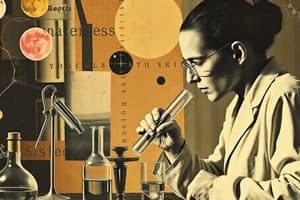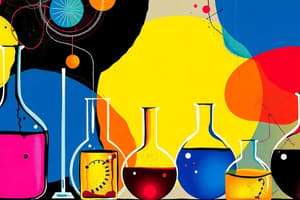Podcast
Questions and Answers
Which principle of scientific inquiry emphasizes the importance of experimental results being consistently reproducible by different scientists?
Which principle of scientific inquiry emphasizes the importance of experimental results being consistently reproducible by different scientists?
- Testability
- Skepticism
- Objectivity
- Repeatability (correct)
A researcher observes a new phenomenon and proposes an explanation that can be tested through experiments. Which step of the scientific method does this BEST exemplify?
A researcher observes a new phenomenon and proposes an explanation that can be tested through experiments. Which step of the scientific method does this BEST exemplify?
- Conclusion Drawing
- Hypothesis Formulation (correct)
- Observation
- Data Analysis
Which of the following scenarios demonstrates a lack of objectivity in scientific research?
Which of the following scenarios demonstrates a lack of objectivity in scientific research?
- A researcher dismisses evidence that contradicts their personal beliefs. (correct)
- A researcher uses statistical analysis to interpret their data.
- A researcher designs an experiment with a control group and a variable group.
- A researcher publishes their findings in a peer-reviewed journal.
A scientist is studying the behavior of a specific group of people within a society. Which branch of science does this research BEST align with?
A scientist is studying the behavior of a specific group of people within a society. Which branch of science does this research BEST align with?
Which of the following research questions would fall under the domain of Earth science?
Which of the following research questions would fall under the domain of Earth science?
A scientist aims to determine the effectiveness of a new drug by administering it to one group of patients and a placebo to another, then comparing the outcomes. Which component of the scientific method is MOST emphasized in this scenario?
A scientist aims to determine the effectiveness of a new drug by administering it to one group of patients and a placebo to another, then comparing the outcomes. Which component of the scientific method is MOST emphasized in this scenario?
In scientific research, what is the primary role of skepticism?
In scientific research, what is the primary role of skepticism?
A researcher is using mathematical models to predict economic trends. Which branch of formal science is being applied in this scenario?
A researcher is using mathematical models to predict economic trends. Which branch of formal science is being applied in this scenario?
Which of the following best exemplifies the relationship between a scientific theory and a scientific law?
Which of the following best exemplifies the relationship between a scientific theory and a scientific law?
A researcher is studying the effects of a new drug on blood pressure. Which tool would be MOST suitable for continuously and non-invasively monitoring a patient's blood pressure during the study?
A researcher is studying the effects of a new drug on blood pressure. Which tool would be MOST suitable for continuously and non-invasively monitoring a patient's blood pressure during the study?
Which of the following is a way that science contributes to addressing societal challenges?
Which of the following is a way that science contributes to addressing societal challenges?
A student measures the length of a table three times and obtains the following measurements: 1.50 m, 1.51 m, and 1.52 m. If the actual length of the table is 1.75 m, how would you describe the student's measurements?
A student measures the length of a table three times and obtains the following measurements: 1.50 m, 1.51 m, and 1.52 m. If the actual length of the table is 1.75 m, how would you describe the student's measurements?
In an experiment, a scientist records the following measurements: 2.5 cm, 2.54 cm, and 2.542 cm. Which measurement demonstrates the highest level of precision?
In an experiment, a scientist records the following measurements: 2.5 cm, 2.54 cm, and 2.542 cm. Which measurement demonstrates the highest level of precision?
A researcher is analyzing the distribution of tree heights in a forest. Which descriptive statistic would be MOST appropriate for determining the most frequently occurring tree height?
A researcher is analyzing the distribution of tree heights in a forest. Which descriptive statistic would be MOST appropriate for determining the most frequently occurring tree height?
When analyzing data, which type of statistics would you use to estimate the average height of all students in a university based on the heights of a randomly selected group of students?
When analyzing data, which type of statistics would you use to estimate the average height of all students in a university based on the heights of a randomly selected group of students?
Which of the following best describes the role of data visualization in science?
Which of the following best describes the role of data visualization in science?
If you have a dataset with one very large outlier, which measure of central tendency would be LEAST affected by the outlier?
If you have a dataset with one very large outlier, which measure of central tendency would be LEAST affected by the outlier?
Why is uncertainty an important consideration when making scientific measurements?
Why is uncertainty an important consideration when making scientific measurements?
Flashcards
Computer Science
Computer Science
Deals with the theory and application of computers and computational systems.
Scientific Theories
Scientific Theories
Well-substantiated explanations based on repeatedly confirmed facts.
Scientific Laws
Scientific Laws
Descriptive statements or equations describing consistent natural relationships.
Microscopes
Microscopes
Signup and view all the flashcards
Telescopes
Telescopes
Signup and view all the flashcards
Measurement
Measurement
Signup and view all the flashcards
Accuracy
Accuracy
Signup and view all the flashcards
Precision
Precision
Signup and view all the flashcards
Significant Figures
Significant Figures
Signup and view all the flashcards
Data Analysis
Data Analysis
Signup and view all the flashcards
What is Science?
What is Science?
Signup and view all the flashcards
Empirical Evidence
Empirical Evidence
Signup and view all the flashcards
Objectivity in Science
Objectivity in Science
Signup and view all the flashcards
Skepticism in Science
Skepticism in Science
Signup and view all the flashcards
Hypothesis Formulation
Hypothesis Formulation
Signup and view all the flashcards
Repeatability in Science
Repeatability in Science
Signup and view all the flashcards
What are the Natural Sciences?
What are the Natural Sciences?
Signup and view all the flashcards
What are the Social Sciences?
What are the Social Sciences?
Signup and view all the flashcards
Study Notes
- A systematic and organized approach to understanding the natural world is achieved through science via observation, experimentation, and analysis.
- Science involves formulating testable hypotheses, conducting experiments to gather data, and drawing conclusions based on the evidence obtained.
Core Principles
- Empirical evidence obtained through observation and experimentation is the basis of science.
- Objectivity is crucial, and scientific findings should be free from personal bias and prejudice.
- Scientists are driven by skepticism to question existing knowledge and explore alternative explanations.
- Scientific hypotheses must be falsifiable through experimentation or observation, making testability essential.
- Repeatability validates findings by ensuring experimental results are reproducible by other scientists.
Scientific Method
- Observation involves carefully noting phenomena or events in the natural world.
- Hypothesis formulation involves developing a testable explanation for the observed phenomena.
- Experimentation involves designing and conducting controlled tests to gather data relevant to the hypothesis.
- Data analysis involves examining and interpreting the data collected during experimentation.
- Conclusion drawing involves evaluating the evidence and determining whether it supports or refutes the hypothesis.
- Communication involves sharing scientific findings with the broader community through publications and presentations.
Branches of Science
- Natural sciences study the physical and biological aspects of the natural world.
- Physics explores the fundamental laws governing matter, energy, and the universe.
- Chemistry investigates the composition, structure, properties, and reactions of matter.
- Biology examines living organisms, their structure, function, growth, evolution, and interactions.
- Earth science studies the Earth's structure, composition, processes, and its place in the universe.
- Social sciences study human behavior, society, and culture.
- Psychology explores the human mind, behavior, and mental processes.
- Sociology examines human society, social interactions, and social institutions.
- Anthropology studies human cultures, societies, and their development.
- Economics analyzes the production, distribution, and consumption of goods and services.
- Formal sciences use formal systems to generate knowledge.
- Mathematics studies abstract structures, relationships, and patterns.
- Logic explores the principles of valid reasoning and inference.
- Statistics involves the collection, analysis, interpretation, presentation, and organization of data.
- Computer science deals with the theory and application of computers and computational systems.
Scientific Theories and Laws
- Scientific theories are well-substantiated explanations of some aspect of the natural world, based on a body of facts that have been repeatedly confirmed through observation and experimentation.
- Theories provide a framework for understanding and predicting phenomena, but they are subject to revision or rejection if new evidence contradicts them.
- Scientific laws are descriptive statements or mathematical equations that describe consistent relationships or regularities observed in nature.
- Laws are generally accepted as universally true and are often expressed as concise mathematical formulas.
Tools and Technologies in Science
- Microscopes enable scientists to observe objects at a microscopic level, revealing details invisible to the naked eye.
- Telescopes allow astronomers to study distant celestial objects, expanding our understanding of the universe.
- Spectrometers analyze the wavelengths of light emitted or absorbed by substances, providing information about their composition and properties.
- Particle accelerators accelerate subatomic particles to high speeds, allowing scientists to probe the fundamental structure of matter.
- Computers facilitate data analysis, simulations, and modeling, accelerating scientific discovery.
Science and Society
- Science plays a crucial role in addressing societal challenges such as climate change, disease, and resource management.
- Scientific discoveries lead to technological innovations that improve our quality of life, such as medical treatments, renewable energy sources, and advanced communication systems.
- Ethical considerations are important in scientific research to ensure that experiments are conducted responsibly and that the potential benefits outweigh the risks.
- Science education equips individuals with critical thinking skills and scientific literacy, enabling them to make informed decisions about science-related issues.
- Public understanding of science is essential for promoting evidence-based policymaking and fostering support for scientific research.
Measurement
- The process of assigning numerical values to physical quantities based on established standards is measurement.
- Accuracy refers to how close a measurement is to the true or accepted value of the quantity being measured.
- Precision refers to the degree of reproducibility or repeatability of a measurement.
- Uncertainty is an estimate of the range of values within which the true value of a measurement likely lies.
- Significant figures are the digits in a number that are known with certainty plus one uncertain digit.
- SI units (International System of Units) are the standard units of measurement used in science, including the meter (m) for length, kilogram (kg) for mass, second (s) for time, ampere (A) for electric current, kelvin (K) for temperature, mole (mol) for amount of substance, and candela (cd) for luminous intensity.
Data Analysis
- Data analysis involves organizing, summarizing, and interpreting data to identify patterns, trends, and relationships.
- Descriptive statistics summarize the main features of a dataset, including measures of central tendency (mean, median, mode) and measures of variability (range, variance, standard deviation).
- Inferential statistics are used to make generalizations about a population based on a sample of data, using techniques such as hypothesis testing, confidence intervals, and regression analysis.
- Data visualization involves creating graphs, charts, and other visual representations of data to facilitate understanding and communication of findings.
Studying That Suits You
Use AI to generate personalized quizzes and flashcards to suit your learning preferences.




